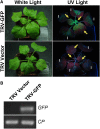Virus-based microRNA silencing in plants
- PMID: 24296072
- PMCID: PMC3875814
- DOI: 10.1104/pp.113.231100
Virus-based microRNA silencing in plants
Abstract
MicroRNAs (miRNAs) play pivotal roles in various biological processes across kingdoms. Many plant miRNAs have been experimentally identified or predicted by bioinformatics mining of small RNA databases. However, the functions of these miRNAs remain largely unknown due to the lack of effective genetic tools. Here, we report a virus-based microRNA silencing (VbMS) system that can be used for functional analysis of plant miRNAs. VbMS is performed through tobacco rattle virus-based expression of miRNA target mimics to silence endogenous miRNAs. VbMS of either miR172 or miR165/166 caused developmental defects in Nicotiana benthamiana. VbMS of miR319 reduced the complexity of tomato (Solanum lycopersicum) compound leaves. These results demonstrate that tobacco rattle virus-based VbMS is a powerful tool to silence endogenous miRNAs and to dissect their functions in different plant species.
Figures







Similar articles
-
An efficient Potato virus X -based microRNA silencing in Nicotiana benthamiana.Sci Rep. 2016 Feb 3;6:20573. doi: 10.1038/srep20573. Sci Rep. 2016. PMID: 26837708 Free PMC article.
-
Virus-Based microRNA Silencing in Plants.Methods Mol Biol. 2020;2172:243-257. doi: 10.1007/978-1-0716-0751-0_18. Methods Mol Biol. 2020. PMID: 32557374
-
Virus-based microRNA expression for gene functional analysis in plants.Plant Physiol. 2010 Jun;153(2):632-41. doi: 10.1104/pp.110.155796. Epub 2010 Apr 13. Plant Physiol. 2010. PMID: 20388670 Free PMC article.
-
MicroRNAs in tomato plants.Sci China Life Sci. 2011 Jul;54(7):599-605. doi: 10.1007/s11427-011-4188-4. Epub 2011 Jul 12. Sci China Life Sci. 2011. PMID: 21748583 Review.
-
Recent advances in tomato functional genomics: utilization of VIGS.Protoplasma. 2012 Oct;249(4):1017-27. doi: 10.1007/s00709-012-0421-7. Epub 2012 Jun 6. Protoplasma. 2012. PMID: 22669349 Review.
Cited by
-
Analysing the loss of embryogenic competence in long-term cell lines of Solanum betaceum Cav.: involvement of miR827, phosphate and sugar.BMC Plant Biol. 2025 Jul 3;25(1):851. doi: 10.1186/s12870-025-06786-2. BMC Plant Biol. 2025. PMID: 40610861 Free PMC article.
-
Silencing of sterol glycosyltransferases modulates the withanolide biosynthesis and leads to compromised basal immunity of Withania somnifera.Sci Rep. 2016 May 5;6:25562. doi: 10.1038/srep25562. Sci Rep. 2016. PMID: 27146059 Free PMC article.
-
Analyses of MiRNA Functions in Maize Using a Newly Developed ZMBJ-CMV-2bN81-STTM Vector.Front Plant Sci. 2019 Oct 17;10:1277. doi: 10.3389/fpls.2019.01277. eCollection 2019. Front Plant Sci. 2019. PMID: 31681375 Free PMC article.
-
Chinese Wheat Mosaic Virus-Induced Gene Silencing in Monocots and Dicots at Low Temperature.Front Plant Sci. 2018 Nov 14;9:1627. doi: 10.3389/fpls.2018.01627. eCollection 2018. Front Plant Sci. 2018. PMID: 30487803 Free PMC article.
-
Functional Identification of Corynespora cassiicola-Responsive miRNAs and Their Targets in Cucumber.Front Plant Sci. 2019 May 31;10:668. doi: 10.3389/fpls.2019.00668. eCollection 2019. Front Plant Sci. 2019. PMID: 31214213 Free PMC article.
References
-
- An G, Ebert PR, Mitra A, Ha SB (1988) Binary vectors. In SB Gelvin, RA Schilperoort, DP Verma, eds, Plant Molecular Biology Manual. Kluwer Academic Publishers, Dordrecht, The Netherlands, pp A3:1–A3:19
-
- Bachan S, Dinesh-Kumar SP. (2012) Tobacco rattle virus (TRV)-based virus-induced gene silencing. Methods Mol Biol 894: 83–92 - PubMed
-
- Bartel DP. (2004) MicroRNAs: genomics, biogenesis, mechanism, and function. Cell 116: 281–297 - PubMed
Publication types
MeSH terms
Substances
LinkOut - more resources
Full Text Sources
Other Literature Sources
Molecular Biology Databases

